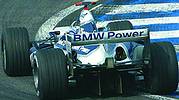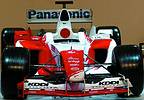Formula 1 racing and Dassault Systèmes
December 2004

In the high-speed world of Grand Prix Formula 1 racing, the battle against time is fought both on and off the track. Formula 1 engineers modify up to 70% of a racecar's 3500 parts during the season. Faced with super-compressed development schedules, and intense pressure to improve car performance, the majority of F1 teams have turned to Dassault Systèmes PLM Solutions.
All the leading F1 teams in the 2003 season (Ferrari, McLaren Mercedes, Williams BMW and Renault) use Catia. For the 2004 season, seven out of the total 10 F1 teams use Catia for chassis development, and six out of 10 use Catia for engine development.
Fast-track development
Dassault Systèmes product development software was originally developed for the aerospace industry. However, the dramatic time savings and design precision attainable through virtual product development is particularly well suited to the F1 industry. Unlike traditional automobile manufacturers who have years to produce a new model, F1 teams produce a brand new car each season and have only six months to do so. In addition, with races scheduled every two weeks, changes to the car made during the season must be performed in record time.
The world's leading 3D collaborative product development solution, Catia enables F1 teams to reduce design and manufacturing time by as much as 40%. The design and analysis of parts in a virtual environment, the ability to re-use existing design data, and the creation of parts using 'intelligent' generative templates all contribute to reducing product development time. When combined with Dassault Systèmes' PLM Best Practices for the F1 industry, the solutions enable engineers to focus on innovation.
For example, aerodynamics engineers at Toyota Motorsport GmbH (TMG) reduced the time required to design new parts by 30% using Dassault Systèmes' Generative Car Design Solution. TMG uses the Catia-based Industry Solution to develop the external shape of the TF104 racecar. TMG's Wind Tunnel Model Design group designs several hundred parts per month for wind-tunnel testing. These aerodynamic designs are scaled up and a full-scale part is created for track tests and races. TMG plans to expand use of the solution to include chassis development.

Shaving off seconds with DS PLM practices
The F1 governing body, the FIA (Fédération International de l'Automobile), sets out a series of precise technical regulations within which each F1 team must design its car. Governed by the same set of specifications, a team's gains in performance (measured in seconds) rarely stem from a single technical feature, but rather from incremental enhancements to the car's aerodynamics, engine, power train, chassis, and suspension. Dassault Systèmes PLM Practices provide field-tested methodologies for each F1 domain and enable engineers to refine every part of the racecar to achieve optimal performance.
DS PLM Practices are specialised best practices or optimal work methodologies based on industry-specific know-how, processes, tools and organisation. They complement Dassault Systèmes' V5 PLM Solutions, accelerate their implementation, and help a company transform and optimise its operations. Dassault Systèmes technical experts customise the PLM Practices for each F1 team.
For example, as part of its Development and Service partnership with TMG announced in January 2004, 10 Dassault Data Services and Dassault Systèmes engineers are working side-by-side with their TMG counterparts at the TMG facilities in Cologne, Germany, to customise DS PLM Practices, support TMG's use of Catia V5 and Enovia and develop new functionalities for the V5 PLM product suite based on the team's requirements.
The human factor
The cockpit is the nucleus of the racecar. It is a confined area that must be both functional and secure for the driver. The Catia V5 Human Modeling module enables F1 designers to minimise the physiological demands placed on drivers from heat, noise, vibration and the car's safety restraints.
Using Catia V5 Human Modeling ergonomics tools, engineers can simulate driver behaviour and measure key criteria such as reach, visibility, comfort, posture, biomechanics, strength and anthropometrics. This analysis enables F1 teams to make driver-oriented decisions about cockpit design, while respecting the overall aerodynamics of the car.
To optimise cockpit ergonomics, F1 teams first create a digital model of each driver using a combination of laser scanning and manual anthropometrical techniques. The resulting virtual models are used to analyse and improve specific accommodation issues such as driver comfort and security, and accessibility and serviceability of components inside the cockpit during pitstops - without the need to involve the actual drivers. The integration of the Human Solutions tools within the PLM platform enables F1 teams to manage ergonomics data in an efficient and intuitive manner within the overall development process of the racecar.
For more information contact Igal Filipovski, CDC, 011 786 3516, igal@cdcza.co.za, www.cdcza.co.za, www.3ds.com
Others who read this also read these articles
The high-end MCAD and cPDm market segments of the PLM strategy
CIMdata considers the high-end MCAD market to include only those few CAD solution providers that deliver very comprehensive computer-aided design and analysis capabilities that are also tightly integrated with an enterprise-capable cPDm solution from the same supplier[ December 2005 ]
SA's prototype designers awarded
The SABS Design Institute is the driving force behind design promotion in the country through various award schemes, supporting innovation and entrepreneurship[ October 2005 ]
2D to 3D: the path to better products, faster and cheaper
Modern 3D CAD systems allow designers and engineers to edit a few parameters and automatically create the downstream deliverables for unique variants in minutes, instead of days or weeks[ October 2005 ]
ECL in Africa
ECL ensures a worldwide coverage of its client base through local service units which incorporate all the ECL know-how[ August 2005 ]
Catia brings business to South Africa
The fact that the A400M contracts were awarded to local enterprises is a strategic breakthrough for the South African aerospace industry[ August 2005 ]
Strand7 analyses the Beijing Water Cube
The latest Strand7 Release 2.3 has added the capability to take site specific seismic time histories and simply create equivalent spectral curves[ June 2005 ]
Pro/E versus SolidWorks
In summary, SolidWorks' swept surfaces and solids are more limited in their capabilities than Pro/Engineer's[ June 2005 ]
Northern Railway Extension receives green light
Windhoek Consulting Engineers was appointed as consulting engineers for the Northern Railway Extension, responsible for all aspects regarding the design and construction supervision of the total project valued at N$ 1,4 billion[ April 2005 ]
Others who read this also read these news items
Digitising a standard racing engine provides a springboard for future improvements
[ December 2005 ]
Nelson Mandela Metropolitan University leads the way with Catia V5
[ December 2005 ]
Integrated CNC solution for SA tooling industry
[ December 2005 ]
Accelerated design at Donkin Fans
[ December 2005 ]
PGF transforms its vision into reality
[ December 2005 ]
Defy introduces new product range
[ October 2005 ]
New Smarts for legal eagles
[ October 2005, Cadshop ]
Vectorworks scores with architects on ease of use
[ October 2005 ]
Others who read this also read these regulars
Search Site
Subscribe
Previous Issues
Other Technews Publications
Other Technews Buyers Guides
 |  | Copyright c1995-2009 Technews Publishing (Pty) Ltd.. All rights reserved. |